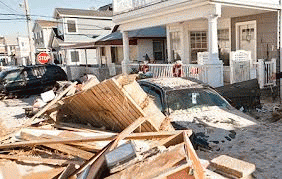In a shameless display
of putting politics before human needs, Congress began 2013 still scrapping
over a $60 billion Hurricane Sandy relief bill fully nine weeks after the
disaster hit. And if the Katrina experience is any indication, the bill may not
bring adequate relief to struggling and displaced homeowners even when it is
finally passed.
The damage wrought by
Sandy to New York and New Jersey coastal areas was similar
in scale to that to New Orleans from Hurricane Katrina in 2005. Just two weeks after Katrina hit, Congress approved $62.3 billion
in emergency appropriations, along with numerous subsequent emergency funding
requests to cover the damages, which topped $100 billion. Yet as noted on the
Occupy Sandy Facebook page, federal relief funds post-Katrina
were gutted in favor of
"privatizing and outsourcing relief, making room for predatory lenders,
disaster capitalists, and gentrification developers."
Most people believe they are protected from disaster
by their insurance policies or by the Federal Emergency Management Agency (FEMA). But many Sandy victims have found that their
insurance policies included obscure provisions that excluded coverage, depending
on such things as whether the disaster was officially classified as a "hurricane"
or a "tropical storm," and whether the damage was from "wind" or "flood." And the only aid they have been offered by FEMA, working in partnership
with Small Business Administrative Disaster Assistance , is the
opportunity to take on more debt. According
to a
report by Strike Debt :
[T]he vast majority of FEMA's resources and efforts are
spent on public assistance grant programs that provide infrastructure
restoration. Individual victims of disaster are mostly offered personal loans
to help them "get back on their feet." Although these loans might seem good on
the surface, they have many features of predatory subprime lending techniques
and ultimately make long-term financial burden the precondition for "recovery."
Disaster victims are now being expected to shoulder
relief expenses that used to be shared publicly. It is a failing of our
austerity-strapped federal disaster relief system that it offers little real
help to individuals; and it is a failing of our private, for-profit insurance
system that the legal duty of management is to extort as much money as possible
from customers while returning as little as possible to them, in order to
maximize shareholder profits.
Most
Sandy Victims Are Left Stranded
The report by Strike Debt was based on observations
made at a community meeting in Midland Beach, Staten Island, on November 18,
2012, as well as on interviews with FEMA and Small Business Association (SBA)
representatives, volunteer workers, local business owners, and residents throughout
New York City. According to the report, there are three main sources of
financial support being offered to Sandy victims: insurance, grants, and loans.
Federal support is available only once private insurance has been exhausted.
For federal aid programs, according to the report:
* Victims are required to
first apply for SBA loans before qualifying to apply for FEMA aid, placing the
economic cost of the disaster on the individual victim.
* Aid programs favor those who can take on debt,
further exacerbating pre-existing inequalities among residents.
* Federal programs are inflexible and fail to
meet even basic individual and community needs.
* Relief options are not clearly communicated or
well understood. Policies are so complex that even lawyers are confused.
Except for temporary living costs, FEMA grants are
accessible only after the homeowner, renter or business applies for an SBA loan. If the applicant qualifies for a loan, he or
she is not likely to be offered further FEMA aid. Disaster loans are made on
the basis of credit history, and favorable interest rates are available only if
the applicant does not have "credit available elsewhere." That means favorable
interest rates are offered only if an applicant cannot qualify for credit
through a commercial bank.
There is no FEMA money for small businesses other
than SBA loans, and businesses have difficulty taking on debt when they don't
know when they will be able to reopen. The SBA application is reported to be at
least 30 pages long, and is often difficult to complete because flooding has
destroyed much of the required paperwork.
Many homeowners were strained by mortgages that were
underwater prior to the storm, and their properties have now depreciated to the
point of having no market value at all.
They have no choice but to try to rebuild, but how can they take on more
debt? The focus on lending, says the Strike
Debt report, moves money from the victims of disaster into the hands of loan
servicers, who make enormous profits off these loans.
(Note: You can view every article as one long page if you sign up as an Advocate Member, or higher).






